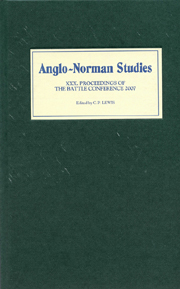Book contents
- Frontmatter
- Contents
- LIST OF ILLUSTRATIONS, MAPS, AND TABLES
- EDITOR'S PREFACE
- ABBREVIATIONS
- The Normans in Welsh History (R. Allen Brown Memorial Lecture)
- William Marshal, Lancelot, and Arthur: Chivalry and Kingship
- Grades of Ordination and Clerical Careers, c. 900–c. 1200
- Evesham J and Evesham L: Two Early Twelfth-Century Manorial Surveys
- Aspects of Church Reform in Wales, c. 1093–c. 1223
- Lay Charters and the Acta of Henry II
- Reinventing Normans as Crusaders? Ralph of Caen's Gesta Tancredi
- Kings, Lords, Charters, and the Political Culture of Twelfth-Century Wales
- Identifying the Warrior on the Pre-Heraldic Battlefield
- St Nicholas the Pilgrim and the City of Trani between Greeks and Normans, c. 1090–c. 1140
- The ‘Resurgence’ of Powys in the Late Eleventh and Early Twelfth Centuries
- Interpreter Families and Anglo-Welsh Relations in the Shropshire-Powys Marches in the Twelfth Century
- A Taste for the Antique? Henry of Blois and the Arts
Identifying the Warrior on the Pre-Heraldic Battlefield
Published online by Cambridge University Press: 12 September 2012
- Frontmatter
- Contents
- LIST OF ILLUSTRATIONS, MAPS, AND TABLES
- EDITOR'S PREFACE
- ABBREVIATIONS
- The Normans in Welsh History (R. Allen Brown Memorial Lecture)
- William Marshal, Lancelot, and Arthur: Chivalry and Kingship
- Grades of Ordination and Clerical Careers, c. 900–c. 1200
- Evesham J and Evesham L: Two Early Twelfth-Century Manorial Surveys
- Aspects of Church Reform in Wales, c. 1093–c. 1223
- Lay Charters and the Acta of Henry II
- Reinventing Normans as Crusaders? Ralph of Caen's Gesta Tancredi
- Kings, Lords, Charters, and the Political Culture of Twelfth-Century Wales
- Identifying the Warrior on the Pre-Heraldic Battlefield
- St Nicholas the Pilgrim and the City of Trani between Greeks and Normans, c. 1090–c. 1140
- The ‘Resurgence’ of Powys in the Late Eleventh and Early Twelfth Centuries
- Interpreter Families and Anglo-Welsh Relations in the Shropshire-Powys Marches in the Twelfth Century
- A Taste for the Antique? Henry of Blois and the Arts
Summary
The battle had reached a crisis point. Hard-pressed by the English, the Normans and their allies were convulsed by a rumour: that William had been killed. The left wing broke and ran. The duke, William of Poitiers wrote,
seeing a great part of the opposing force springing forward to pursue his men, rushed towards them, met them as they fled and halted them, striking out and threatening with his spear. Baring his head and lifting his helmet, he cried ‘Look at me? I am alive, and with God's help I will conquer. What madness is persuading you to flee? What way is open to escape?’ At these words they recovered their courage.
In his work on the twelfth-century birth of heraldry, Adrian Ailes uses this episode as an example of the difficulties that the knights of the pre-heraldic eleventh century had in being recognized on the battlefield. He cites similar examples: the rallying of the English by Edmund Ironside in 1016, when the king also lifted his helmet to show his face, Robert Curthose's near-slaying of his father at Gerberoy in 1079, and Rufus's near-miss in 1091; on the two latter occasions the assailant's hand was stayed only when he recognized his intended victim's voice. Ailes argues that before the development of heraldry it was almost impossible for the individual warrior to be identified. In the first third of the twelfth century, he suggests, shield designs became more systematized and ordered, but only after 1150 were the designs on a knight's shield used consistently, inherited by sons from their fathers, and followed a set of rules as to their shape, position, and colour, which are the defining characteristics of heraldic display.
- Type
- Chapter
- Information
- Anglo-Norman Studies 30Proceedings of the Battle Conference 2007, pp. 154 - 167Publisher: Boydell & BrewerPrint publication year: 2008



